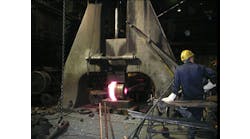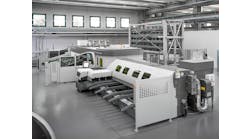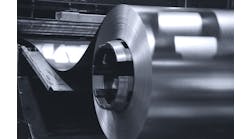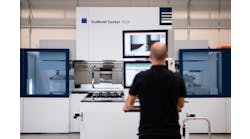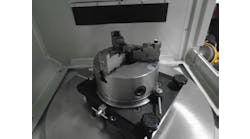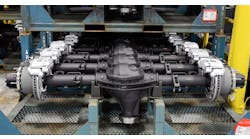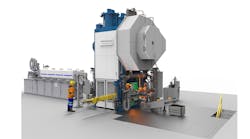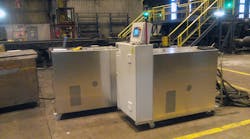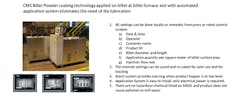Die lubricants are used to reduce friction between die and part, and act as release agents to prevent sticking and reduce die wear. Graphite water-based formulations are the most common lubricants used today, together with so called “white” lubricants. For lubricants to perform properly, dies must be maintained within a certain temperature range – hot enough for lubricant to dry, but cool enough for lubricant to adhere to the die surface.
However, highly diluted lubricants also are also used to cool the dies, resulting in excessive waste, high pollution, and ever-changing frictional conditions. Furthermore, excessive die cooling causes high thermal cycling that contributes to die failures and cool dies steal temperature from parts being forged.
In some forging operations, billet coatings are used only when one forging step is required. The billet coatings are applied in a separate process step before billets enter the furnace for heating. Again, graphite-based billet coatings are the most common. On negative side, billet coatings do not prevent oxidation during heating, and so the effect of billet coating is minimal coating flaking off with the scale formed during heating.
Oxidation/scale formation
The global steel industry produces over 1.8 billion tons of steel annually. In a typical steelmaking operation, scale forms during casting and re-heating and subsequent processing when the hot metal surface is exposed to air (oxygen.) Unrecoverable yield losses may be as much as €2 per ton of steel produced. In addition, scale causes surface-quality issues, tool/roll wear and high finishing costs of the hot-rolled products. The oxidation ratio depends on temperature and heating time.
For carbon steel, the tertiary scale formed at high temperatures usually consists of three iron oxide phases: the inner Wüstite (FeO), magnetite (Fe3O4), and the outer layer hematite (a-Fe2O3.) However, the heating time in a typical forging shop induction furnace is short and the formation is not as significant as in typical steel mill re-heating furnace.
Due to well know negative effects of scale formation, such as high tool wear, scale defect, yield losses, etc., several EU-sponsored studies have been carried out to address the issue.
CMS test results
In 2018, Coating Management Switzerland (CMS) started its own R&D program focused on scale formation and friction. To address the issue, a special coating powder is applied to the billet surface using a fully automated, PLC-controlled system at the furnace exit. The coating powder melts on contact with the hot surface, forming a liquid coating, liquid lubricant, that remains liquid as long as the billet surface temperature remains over 600° C.
There is no upper limit on surface temperature. Powder turned into a liquid seals the surface while providing lubrication for up to seven subsequent hot forming steps.
CMS powder working principle is demonstrated.
During the testing CMS powder was applied to the hot billet surface at various rates. Based on tests, 20 to 40 grams of powder per square meter of billet surface area is required to provide effective film thickness.
Results show that when CMS Surface Treatment powder is applied on the hot surface of steel:
1. Existing scale is converted to soft paste.
2. Further scale formation is eliminated.
3. The formed soft paste acts as a lubricant, reducing friction.
4. There is no pick-up of molten powder on tooling.
5. The formed liquid lubricant remains active up to seven consecutive hot-forming steps.
6. Due to high viscosity, the formed lubricant does not “run off” the surface and also stays on the bottom side of the billet.
7. Scale formation between subsequent hot forming processes is eliminated.
8. No scale is formed during final cooling.
9. Surface scale after final cooling, if any, is easily removable without pickling or shot blasting.
Safety
The Material Safety Data (MSD) sheet states that there are no hazardous components in CMS powder, such as borax, and the powder does not cause pollution to water or corrosion. Furthermore, the powder does not create smoke, flame, or odors when applied on hot surfaces.
Application of Surface Treatment Powder
Powder application is done when billet exits the furnace. The application quantity depends on number of passes, hits are performed after application, but this is typically between 20 grams and 40 grams of powder per square meter of part, billet, surface area. The billet minimum temperature during application must exceed 650° C, and there is no upper limit to the temperature.
The powder is supplied in plastic pails. Powder is introduced into Powder Application Unit product tank automatically or manually. The Powder Injection Unit consists of a PLC-controlled powder injection system connected to spray box surrounding the part, or billet. The Spray Box with exhaust system is used to prevent any powder dust from entering the plant atmosphere.The powder application quantity is adjusted from the Powder Injection Unit touch screen, or remotely from press or robot control screen. All entered settings are stored and can be recalled for future use.
Potential benefits for forging
1. Elimination of scale formation after billet exists the furnace before forging
2. Elimination of scale formation on re-heats
3. Elimination of die lubrication and associated equipment costs
4. Elimination of pollution caused by die lubrication
5. Reduced operating costs, die lubrication equipment and maintenance eliminated
6. Elimination waste lubricant re-cycling, disposal costs and related house keeping
7. Greatly increased productivity, die lubrication cycle eliminated
8. Consistent friction regardless of die temperatures, lubricant is on billet
9. Improved tolerances due to consistent friction, reduced trimming
10. Reduced heat losses of die, cooling for lubricant is eliminated and dies can be run hotter
11. Improved die life, dies can be run hotter, less thermal cycling
12. Die wear caused by hard oxide is eliminated further increasing die life
13. Elimination of die pre-heating
14. Elimination of scale formation during final cooling
15. Reduced part cleaning costs
16. Reduced scrap
As indicated above, all testing with CMS Surface Treating powder has been done during rolling. However, CMS powder is expected to provide significant operational, quality and cost benefits for forging operations while reducing pollution and waste.
This is specifically the case for closed-die forging processes, net-shape applications, and applications where cycle time is only few seconds. For large forgings, and for specialty steels, titanium, etc., CMS coating can be applied with a hand wand or with automated spray arms well before forging, as the coating remains active as long as billet temperature remains over 650 C. The reduction in friction stays consistent regardless of the time between product application and forging.
Coating Management Switzerland (CMS) is now seeking forging shop(s) to conduct tests to establish the cost and process benefits of CMS coating technology. A co-operating partner will benefit substantially for its contributions during testing and for being a reference. Full test results and additional videos are available upon request.
Raimo Peltoniemi is the president of Coating Management Switzerland GmbH. Contact him at [email protected]

